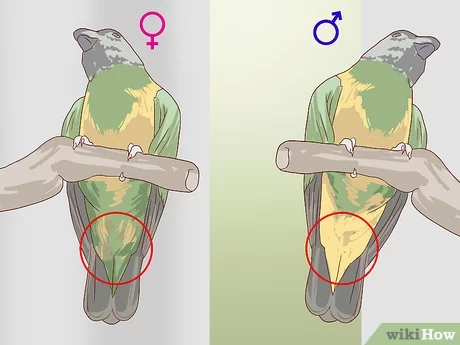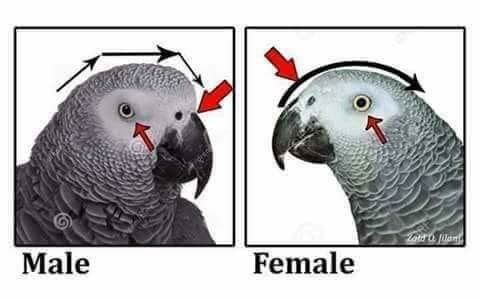
Determining the gender of your parrot can be a challenging but important aspect of bird ownership. Knowing whether your parrot is male or female can help you understand their behavior, provide appropriate care, and make informed breeding decisions. While some parrot species exhibit obvious physical differences between males and females, others require more subtle methods to determine gender. In this article, we will explore the various ways to determine the gender of your parrot.
Visual Differences
In some parrot species, males and females exhibit clear physical differences, known as sexual dimorphism. These differences can make it relatively easy to determine the gender of your bird.
- Eclectus Parrots: Males are typically bright green with orange beaks, while females are red with blue or purple markings and black beaks.
- Budgerigars (Budgies): Males usually have a blue cere (the fleshy area above the beak), while females have a brown or tan cere, especially during breeding season.
- Indian Ringneck Parakeets: Males develop a distinctive black and pink ring around their necks as they mature, while females generally lack this marking.
Visual differences can be quite pronounced in these species, making gender identification straightforward. However, not all parrots exhibit such clear distinctions, and some species look remarkably similar regardless of gender.
In some species, feather coloration and markings can also indicate gender:
- Cockatoos: Male cockatoos often have darker eyes, while females tend to have lighter, reddish-brown eyes.
- Canaries: Male canaries typically have brighter, more vibrant plumage compared to females, who usually have duller colors.
These visual cues can be helpful, but they are not always definitive. Some birds may display intermediate characteristics or atypical coloration, making it harder to rely solely on visual differences.
Behavioral Differences
In many parrot species, males and females may display different behaviors or vocalizations, particularly during the breeding season. Observing these behaviors can provide clues about your parrot’s gender.
- Cockatiels: Male cockatiels are often more vocal and may sing or whistle more frequently than females. They may also perform courtship displays, such as spreading their wings and bobbing their heads.
- Lovebirds: Males tend to be more active and may engage in more frequent courtship behaviors, such as feeding the female or performing mating dances.
- African Greys: Male African Greys may be more likely to mimic sounds and engage in more exploratory behaviors, while females might be more reserved.
While behavioral differences can offer clues, they are not always definitive. Individual personalities and environmental factors can influence behavior, making it an unreliable method for gender determination in some cases.
During the breeding season, female parrots may exhibit nesting behaviors such as shredding paper, digging, or spending more time in dark, enclosed spaces. These behaviors can indicate a female, especially if the parrot shows no interest in such activities outside the breeding season.

DNA Testing
One of the most accurate ways to determine the gender of your parrot is through DNA testing. This method involves taking a small sample of your bird’s blood, feathers, or eggshell, which is then analyzed in a laboratory to identify the sex chromosomes.
- Blood Sample: A small drop of blood is collected from your parrot, typically from a toenail or a vein. This sample is then sent to a laboratory for analysis.
- Feather Sample: A few freshly plucked feathers can be used for DNA testing. The feathers must be plucked, not molted, to ensure they contain viable genetic material.
- Eggshell Sample: If your parrot has recently hatched, a small piece of the eggshell can be used for DNA testing.
DNA testing is highly accurate and can determine the gender of your parrot regardless of species or age. Many avian veterinarians and specialized laboratories offer this service, making it accessible and reliable.
Surgical Sexing
Another method for determining the gender of your parrot is surgical sexing, which involves an endoscopic examination of the bird’s internal reproductive organs. This procedure is typically performed by an avian veterinarian under anesthesia.
- Procedure: A small incision is made in the bird’s abdomen, and a tiny camera (endoscope) is inserted to visualize the reproductive organs. The presence of testes indicates a male, while ovaries indicate a female.
- Accuracy: Surgical sexing is highly accurate but carries some risks due to the invasive nature of the procedure and the need for anesthesia.
Surgical sexing is usually reserved for breeding purposes or when other methods are inconclusive. It provides immediate and definitive results but is not commonly performed for routine gender determination.
Consulting with Experts
If you are unsure about your parrot’s gender, consulting with an avian veterinarian or an experienced breeder can be helpful. These experts can provide guidance on the most appropriate method for your specific bird and assist with the testing process.
- Veterinarian Consultation: Avian veterinarians can perform DNA tests or surgical sexing and provide insights based on physical examination and behavioral observations.
- Breeder Consultation: Experienced breeders may be familiar with the subtle differences in specific parrot species and can offer valuable advice on gender determination.
Seeking expert advice ensures that you are using the most effective and appropriate method for determining your parrot’s gender.
Conclusion
Determining the gender of your parrot is an important aspect of bird care that can influence behavior management, breeding decisions, and overall health. Whether through visual differences, behavioral observations, DNA testing, or surgical sexing, understanding your parrot’s gender helps you provide better care and enrich their lives. By using the right methods and seeking expert guidance, you can accurately determine the gender of your parrot and ensure a happy and healthy relationship with your feathered friend.
Understanding your parrot’s gender not only satisfies curiosity but also enhances your ability to meet their specific needs and ensure their well-being. With the right approach, you can accurately identify whether your parrot is a boy or girl and enjoy a more informed and fulfilling companionship.
